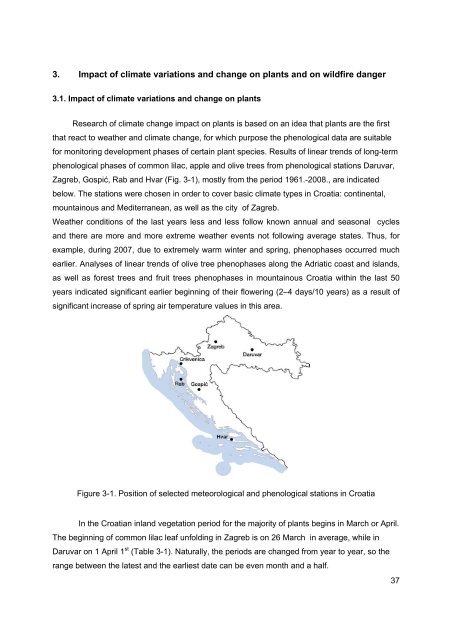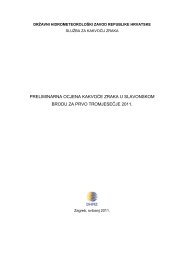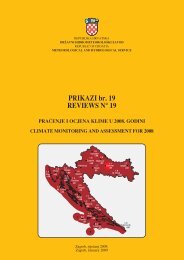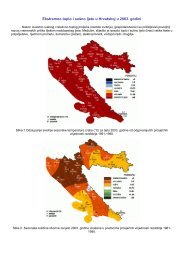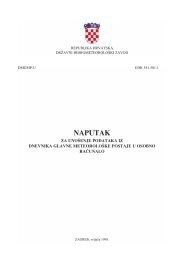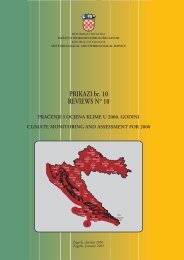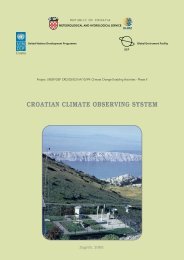Observed climate changes in Croatia Climate change scenario
Observed climate changes in Croatia Climate change scenario
Observed climate changes in Croatia Climate change scenario
Create successful ePaper yourself
Turn your PDF publications into a flip-book with our unique Google optimized e-Paper software.
3. Impact of <strong>climate</strong> variations and <strong>change</strong> on plants and on wildfire danger<br />
3.1. Impact of <strong>climate</strong> variations and <strong>change</strong> on plants<br />
Research of <strong>climate</strong> <strong>change</strong> impact on plants is based on an idea that plants are the first<br />
that react to weather and <strong>climate</strong> <strong>change</strong>, for which purpose the phenological data are suitable<br />
for monitor<strong>in</strong>g development phases of certa<strong>in</strong> plant species. Results of l<strong>in</strong>ear trends of long-term<br />
phenological phases of common lilac, apple and olive trees from phenological stations Daruvar,<br />
Zagreb, Gospić, Rab and Hvar (Fig. 3-1), mostly from the period 1961.-2008., are <strong>in</strong>dicated<br />
below. The stations were chosen <strong>in</strong> order to cover basic <strong>climate</strong> types <strong>in</strong> <strong>Croatia</strong>: cont<strong>in</strong>ental,<br />
mounta<strong>in</strong>ous and Mediterranean, as well as the city of Zagreb.<br />
Weather conditions of the last years less and less follow known annual and seasonal cycles<br />
and there are more and more extreme weather events not follow<strong>in</strong>g average states. Thus, for<br />
example, dur<strong>in</strong>g 2007, due to extremely warm w<strong>in</strong>ter and spr<strong>in</strong>g, phenophases occurred much<br />
earlier. Analyses of l<strong>in</strong>ear trends of olive tree phenophases along the Adriatic coast and islands,<br />
as well as forest trees and fruit trees phenophases <strong>in</strong> mounta<strong>in</strong>ous <strong>Croatia</strong> with<strong>in</strong> the last 50<br />
years <strong>in</strong>dicated significant earlier beg<strong>in</strong>n<strong>in</strong>g of their flower<strong>in</strong>g (2–4 days/10 years) as a result of<br />
significant <strong>in</strong>crease of spr<strong>in</strong>g air temperature values <strong>in</strong> this area.<br />
Figure 3-1. Position of selected meteorological and phenological stations <strong>in</strong> <strong>Croatia</strong><br />
In the <strong>Croatia</strong>n <strong>in</strong>land vegetation period for the majority of plants beg<strong>in</strong>s <strong>in</strong> March or April.<br />
The beg<strong>in</strong>n<strong>in</strong>g of common lilac leaf unfold<strong>in</strong>g <strong>in</strong> Zagreb is on 26 March <strong>in</strong> average, while <strong>in</strong><br />
Daruvar on 1 April 1 st (Table 3-1). Naturally, the periods are <strong>change</strong>d from year to year, so the<br />
range between the latest and the earliest date can be even month and a half.<br />
37


